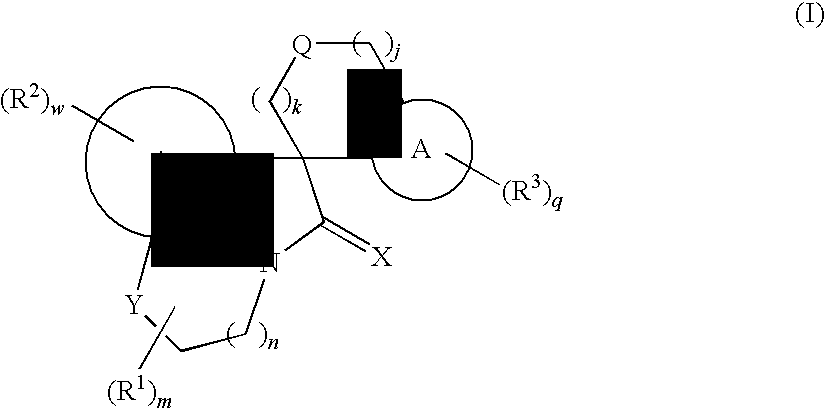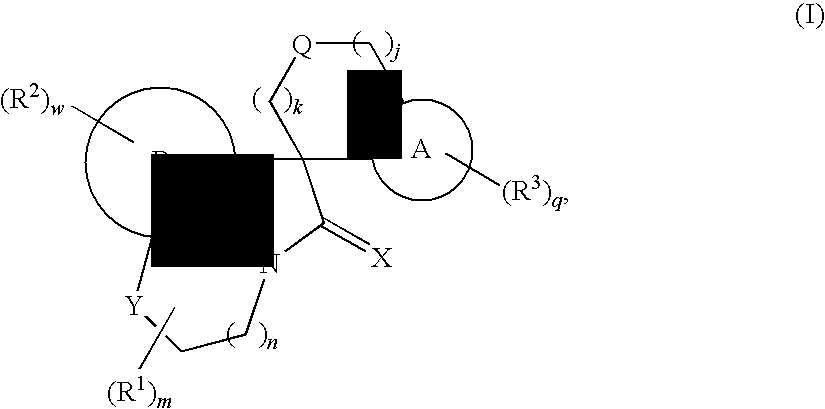Tricyclic spiro-oxindole derivatives and their uses as therapeutic agents
a technology of spiro-oxindole and derivatives, which is applied in the direction of drug composition, biocide, metabolism disorder, etc., can solve the problems of major pathophysiological conditions, major changes, and unoptimized potency and therapeutic index of spiro-oxindole, so as to increase the potency of existing or future drug therapy and reduce adverse events
- Summary
- Abstract
- Description
- Claims
- Application Information
AI Technical Summary
Benefits of technology
Problems solved by technology
Method used
Image
Examples
synthetic example 1
Synthesis of 3′,4′-Dihydro-2′H-spiro[furo[2,3-f][1,3]benzodioxole-7,7′-[1,4]thiazepino[2,3,4-hi]indol]-6′-one
[0486]
[0487]To a solution of diethyl azodicarboxylate (0.30 g, 1.70 mmol) in tetrahydrofuran (20 mL) was added triphenylphosphine (0.45 g, 1.70 mmol) and the reaction mixture was stirred for 30 minutes. To this was added a solution of 7-(6-hydroxy-1,3-benzodioxol-5-yl)-7-(hydroxymethyl)-3,4-dihydro-2H-[1,4]thiazepino[2,3,4-hi]indol-6(7H)-one (0.63 g, 1.70 mmol) in tetrahydrofuran (30 mL) at 0° C. The reaction mixture was stirred at ambient temperature for 16 hours, quenched with saturated ammonium chloride solution (5 mL) and diluted with ethyl acetate (200 mL). The organic layer was washed with 2 M hydrochloric acid solution (50 mL), water (100 mL), dried over sodium sulfate and filtered. The filtrate was concentrated under reduced pressure to dryness. The residue was purified by silica gel column chromatography eluting with ethyl acetate:hexane (20% to 60% gradient) to give...
synthetic example 2
Synthesis of 3′,4′-Dihydro-2′H-spiro[furo[2,3-f][1,3]benzodioxole-7,7′-[1,4]oxazepino[2,3,4-hi]indol]-6′-one
[0488]
[0489]To a suspension of cesium carbonate (3.00 g, 9.20 mmol) in tetrahydrofuran (30 mL) was added a solution of 7-(6-hydroxy-1,3-benzodioxol-5-yl)-3,4-dihydro-2H-[1,4]oxazepino[2,3,4-hi]indol-6(7H)-one (1.20 g, 3.70 mmol) and chloroiodomethane (2.00 g, 11.0 mmol) in tetrahydrofuran (20 mL). The reaction mixture was stirred under argon atmosphere at ambient temperature for 20 hours and filtered. The filtrate was concentrated under reduced pressure to dryness and the residue was recrystallized from ethyl acetate:hexane to yield the title compound (0.91 g, 73%) as a colorless solid. The compound was purified by silica gel column chromatography eluting with ethyl acetate:hexane (15% to 70% gradient) to generate 3′,4′-dihydro-2′H-spiro[furo[2,3-f][1,3]benzodioxole-7,7′-[1,4]oxazepino[2,3,4-hi]indol]-6′-one (0.77 g, 62%): mp 226-227° C.; 1H NMR (300 MHz, DMSO-d6) δ 6.93-6.69 ...
synthetic example 3
Synthesis of 8,9,10,11-Tetrahydro-4H-spiro[azocino[3,2,1-hi]indole-4,7′-furo[2,3-f][1,3]benzodioxol]-5-one
[0490]
[0491]Following the procedure as described in SYNTHETIC EXAMPLE 2, and making non-critical variations to replace 7-(6-hydroxy-1,3-benzodioxol-5-yl)-3,4-dihydro-2H-[1,4]oxazepino[2,3,4-hi]indol-6(7H)-one with 1-(6-hydroxy-1,3-benzodioxol-5-yl)-5,6,7,8-tetrahydro-4H-azocino[3,2,1-hi]indol-2(1H)-one, 8,9,10,11-tetrahydro-4H-spiro[azocino[3,2,1-hi]indole-4,7′-furo[2,3-f][1,3]benzodioxol]-5-one was obtained (45%) as a colorless solid: mp 176-177° C.; 1H NMR (300 MHz, DMSO-d6) δ 7.04-6.85 (m, 3H), 6.63 (s, 1H), 6.13 (s, 1H), 5.87 (s, 2H), 4.69 (ABq, 2H), 4.19-3.91 (m, 2H), 3.18-2.93 (m, 2H), 1.84-1.71 (m, 4H), 1.49-1.37 (m, 2H); 13C NMR (75 MHz, DMSO-d6) δ 177.0, 155.7, 148.7, 143.1, 142.2, 132.2, 131.8, 123.7, 123.5, 122.1, 120.8, 103.3, 101.9, 93.7, 80.4, 57.6, 39.8, 31.1, 29.5, 29.1, 21.5; MS (ES+) m / z 338.3 (M+1).
PUM
| Property | Measurement | Unit |
|---|---|---|
| body weight | aaaaa | aaaaa |
| temperature | aaaaa | aaaaa |
| voltage | aaaaa | aaaaa |
Abstract
Description
Claims
Application Information
 Login to View More
Login to View More - R&D
- Intellectual Property
- Life Sciences
- Materials
- Tech Scout
- Unparalleled Data Quality
- Higher Quality Content
- 60% Fewer Hallucinations
Browse by: Latest US Patents, China's latest patents, Technical Efficacy Thesaurus, Application Domain, Technology Topic, Popular Technical Reports.
© 2025 PatSnap. All rights reserved.Legal|Privacy policy|Modern Slavery Act Transparency Statement|Sitemap|About US| Contact US: help@patsnap.com



